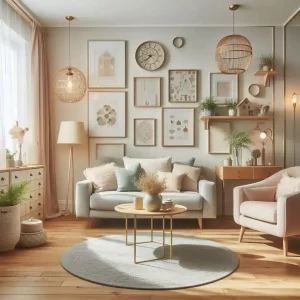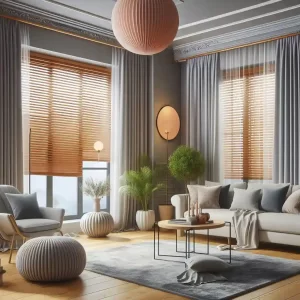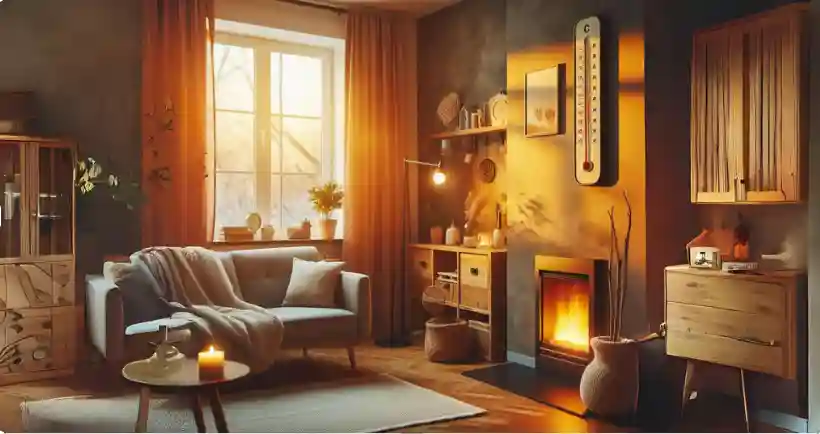As temperatures rise, decreasing home temperature becomes essential for comfort. Interior design plays a key role in regulating indoor temperature. Thoughtful design choices by Tarunna Design can create a cooler, more comfortable environment. Here are detailed strategies from Tarunna Design to help decrease your home temperature through interior design.
1. Choose Light Colors for Walls and Furniture
 One of the most effective ways to keep your home cool is by selecting light colors for your walls and furniture. Light shades, such as whites, pastels, and light grays, reflect sunlight rather than absorb it. This reflection reduces heat accumulation inside your home.
One of the most effective ways to keep your home cool is by selecting light colors for your walls and furniture. Light shades, such as whites, pastels, and light grays, reflect sunlight rather than absorb it. This reflection reduces heat accumulation inside your home.
Why it works: Dark colors absorb more heat, while light colors reflect it, keeping your rooms cooler. For instance, painting your walls white or a light pastel can lower the indoor temperature by a few degrees compared to darker hues.
Tips: Use light-colored upholstery and decor items like cushions, rugs, and curtains to enhance the cooling effect.
2. Use Natural Fabrics
Natural fabrics, such as cotton and linen, are breathable and help maintain a cooler environment. These materials allow air to circulate better than synthetic fabrics, which can trap heat.
Why it works: Natural fabrics wick away moisture and allow air to flow, creating a cooling effect. Cotton and linen, in particular, have been used for centuries in hot climates for their cooling properties.
Tips: Choose cotton or linen curtains, upholstery, and bedding. These fabrics not only keep your home cool but also add a touch of elegance and comfort.
3. Install Blinds or Shades
 Blinds and shades are practical solutions for blocking out the sun’s rays. Reflective or blackout shades are particularly effective in reducing heat.
Blinds and shades are practical solutions for blocking out the sun’s rays. Reflective or blackout shades are particularly effective in reducing heat.
Why it works: These window treatments can block up to 90% of sunlight, significantly reducing heat gain. By preventing the sun from entering your home, you can keep your indoor temperature lower.
Tips: Install reflective or blackout blinds on windows that receive direct sunlight. Consider motorized blinds for convenience, allowing you to adjust them easily based on the time of day.
4. Incorporate Plants
Indoor plants not only beautify your space but also help cool the air. Plants release moisture through a process called transpiration, which cools the surrounding air.
Why it works: Plants like ferns, aloe vera, and snake plants are particularly effective at releasing moisture and reducing air temperature. They also improve indoor air quality by absorbing toxins.
Tips: Place plants near windows to block direct sunlight and add a natural cooling element. Create a green wall or indoor garden for an aesthetically pleasing and cooling effect.
5. Improve Ventilation
Proper ventilation is crucial for maintaining a cool home. Ensure that your windows and doors can open fully to let in fresh air. Ceiling fans can also enhance air circulation.
Why it works: Good airflow helps dissipate heat and bring in cooler air from outside. Ceiling fans create a breeze that can make a room feel cooler by several degrees.
Tips: Use cross-ventilation by opening windows on opposite sides of a room. Install exhaust fans in kitchens and bathrooms to remove hot air and humidity.
6. Opt for Heat-Reflective Roofing
Investing in heat-reflective roofing materials can make a significant difference in your home’s temperature. These materials are designed to reflect more sunlight and absorb less heat.
Why it works: Heat-reflective roofing can reduce the temperature of your roof by up to 50 degrees, resulting in a cooler indoor environment. This reduces the need for air conditioning, saving energy and money.
Tips: Consider cool roofs made of materials like reflective tiles, metal, or specially coated shingles. Consult with a roofing expert to choose the best option for your home.
7. Use Area Rugs Wisely
Hardwood and tile floors can become hot during the summer. Using light-colored area rugs can help keep your floors cooler.
Why it works: Rugs made from natural fibers like jute or cotton can act as insulators, keeping your floors cool to the touch. They also add comfort and style to your space.
Tips: Choose rugs that are easy to clean and maintain. Place them in high-traffic areas to maximize their cooling effect.
8. Implement Smart Lighting
Traditional incandescent bulbs generate a lot of heat. Switching to LED lights can reduce the amount of heat produced. Additionally, smart lighting systems can adjust brightness based on the time of day.
Why it works: LED lights produce less heat and use less energy, contributing to a cooler home. Smart lighting systems can be programmed to dim during the hottest parts of the day, reducing heat buildup.
Tips: Replace incandescent bulbs with LED alternatives. Use smart lighting controls to automate lighting adjustments and reduce heat gain.
9. Install Insulated Windows
Double-glazed or insulated windows are excellent for maintaining indoor temperature. They keep the heat out during summer and the warmth in during winter, making them a worthwhile investment for year-round comfort.
Why it works: Insulated windows reduce the transfer of heat through glass, keeping your home cooler in the summer. They also reduce energy costs by improving overall insulation.
Tips: Look for windows with a low-emissivity (Low-E) coating, which reflects heat while allowing light to pass through. Consider window films as a cost-effective alternative to replacing windows.
10. Create Shade Outdoors
External shading solutions, like awnings or pergolas, can block the sun before it even reaches your windows. Planting trees or tall shrubs around your home also provides natural shade and reduces the heat entering your home.
Why it works: Shading the exterior of your home prevents heat from building up inside. Trees and shrubs not only provide shade but also cool the air through transpiration.
Tips: Install awnings or pergolas over windows and patios. Plant deciduous trees, which provide shade in the summer and let sunlight through in the winter when they lose their leaves.
11. Optimize Window Placement
If you’re planning a renovation or building a new home, consider the placement of your windows. North-facing windows receive less direct sunlight and stay cooler.
Why it works: Proper window placement can minimize heat gain from direct sunlight. North-facing windows provide consistent natural light without the intense heat of the sun.
Tips: During the design phase, work with an architect to optimize window placement. Consider installing larger windows on the north side of your home and smaller windows on the south side.
12. Use Reflective Window Film
Reflective window film can reduce the amount of heat that enters your home. These films are easy to apply and can significantly lower indoor temperatures.
Why it works: Reflective films block up to 79% of solar heat, keeping your home cooler. They also reduce glare and protect furniture from fading due to UV exposure.
Tips: Apply reflective film to windows that receive the most sunlight. Choose high-quality films that offer both heat reduction and UV protection.
By incorporating these design elements, you can effectively lower the temperature in your home. Not only will these changes make your living space more comfortable, but they can also help reduce energy costs by minimizing the need for air conditioning. Start with a few of these tips and enjoy a cooler, more pleasant home environment.
In conclusion, a cool home is not just about cranking up the air conditioning. Smart interior design choices can make a significant difference in maintaining a comfortable temperature. By choosing light colors, using natural fabrics, improving ventilation, and incorporating plants, you can create a cooler and more enjoyable living space. Whether you’re making minor adjustments or planning a major renovation, these strategies can help you achieve a cooler home. Stay with Tarunna Design.

